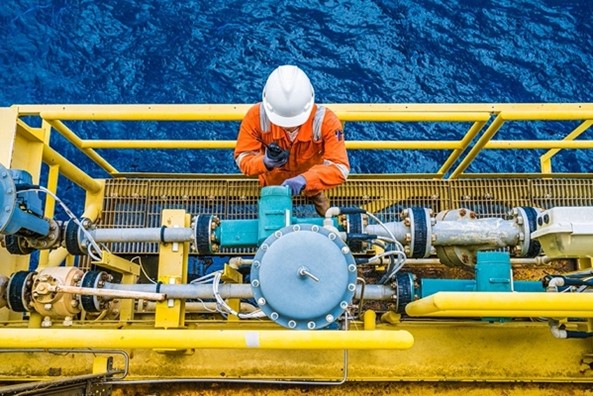The High Standards of Standards Development
— May 1, 2024
This article first appeared on World Oil.com.
Picture this: In the frigid, remote waters of the North Sea, an offshore oil rig faces a daunting challenge. A seal on a subsea control module has ruptured, grinding production to a halt. Repairing the module is relatively straightforward—that is, with an available replacement. The problem on this particular day: The rig is out of new seals, and the nearest replacement is thousands of miles away.
In this hypothetical scenario, there would be concern for potential safety and environmental issues posed by delays getting a replacement seal to the rig – not to mention financial considerations. This kind of problem is not unusual in the natural gas and oil industry, where remote operations present challenges in managing complex supply chains. Yet, the industry has a history of meeting challenges through innovative solutions and technologies.
Enter 3D printing, also known as additive manufacturing. This on-demand manufacturing process offers the ability to manufacture essential components on-site, wherever and whenever they’re needed, to significantly reduce lead times and simplify logistical complexities. Industry use of 3D printing has accelerated as a valuable tool for advancing safety and quality – and with it the need for standards.

On-demand, 3D printing offers the ability to manufacture essential components on-site, wherever and whenever they’re needed.
That’s where the American Petroleum Institute (API) has stepped in. Recognizing the critical role of safety in using 3D printing, API tapped industry stakeholders help develop effective solutions. Their efforts led to standards leading to transformative changes in the way 3D printing works in industry operations.
In 2021, API published Standard 20S, Additively Manufactured Metallic Components for Use in the Petroleum and Natural Gas Industries. This was followed in 2022 by the introduction of API Standard 20T, Additively Manufactured Polymer-Based Components. Both demonstrate a proactive approach to embracing 3D printing and its rapid evolution. The standards addressed quality assurance, safety, and compatibility in using 3D-printed components in critical oil and natural gas operations.
Developing the standards capitalized on decades of work and industry practices to address proper testing, classification, and handling around equipment and components used in oil operations. It also highlighted API’s meticulous work and approach as one of the oldest petroleum standards-setting organizations in the world. If necessity is the mother of invention, so too, is the inspiration for standards and recommended practices. No matter which of API’s more than 800 standards you consider, their development, from concept to publication, involves a robust process (much like they did for API Standards 20S and 20T).
Let’s take a closer look.
Quick Guide to API Standards Development Process
For nearly a century, API has been a global leader in convening subject matter experts to establish and maintain standards for the natural gas and oil industry. The API catalog of standards and other documents – including a record 95 standards published in 2022 – help enhance operational safety, quality, consistency, interoperability, and reliability of equipment and materials across a global industry.
Standards on Developing Standards
API follows established procedures for developing all standards, whether published exclusively by API or jointly with other standards-developing organizations. API is accredited as a standards developer by the American National Standards Institute (ANSI), which contributes to the recognition of API standards across industry and regulatory bodies.
A chief characteristic of API’s standards development process is that draft standards are available to interested parties for review and comment. This collective effort strives for balance, consensus and due process, ultimately contributing to a standard’s technical integrity.

Collaboration and consensus-building are foundational to API’s systematic standards development process.
Developing a new standard begins when an API standards committee member or other interested party believes a new standard is needed – to enhance safety, facilitate equipment manufacturing, or address industry operations – and they submit a request to API for consideration.
Once a standards request is approved by an API standards governance committee, it is assigned to a committee or work group for review. These panels include subject matter experts experienced in developing, revising and maintaining standards and other technical publications.
Broad participation is sought from parties that have a direct and material interest in the proposed standard, as well as relevant work experience.
The drafting or pre-ballot phase comes next. Drafting a standard may take many months and may incorporate research funded solely by API or jointly with other organizations.
Once drafting is complete, the standard’s merits are assessed by a consensus or voting body comprised of representatives from three or more categories—typically natural gas and oil operator-users; manufacturer-service suppliers; and general interest (e.g. consultants, government agencies, academics, and nongovernmental organizations).
Voting members (those part of the consensus body) review the draft standard, provide comments, and ultimately vote on whether it should be published as an API standard. Other non-voting, interested parties can submit comments on the ballot draft. Balloting is conducted using API’s e-ballot system, and all API standards ballots are open for public review through the API Open Ballots website.
Those casting a negative vote must explain their reasoning. The standards committee must consider all comments, whether from a consensus body member or the public, and attempt to resolve them. If their review results in substantive changes, then an updated draft is submitted for review (again) by the consensus body.
The goal of balloting and comment resolution is to reach a consensus, but not necessarily unanimity. Consensus requires that at least 50% of the voters return their ballots, with at least two-thirds of the respondents approving.
Once the new standard is approved, it goes through legal review and receives final editing at API. The new standard is then published and made available to the industry and public.
Once published, standards have to be maintained and must be reviewed every five years to remain current. If the standards committee determines no updates are needed, the standard is balloted for reaffirmation.
Occasionally, it is determined that a standard does not need to be maintained, and no longer is reviewed or considered for updating. Once such standards have been withdrawn, (“historical”) copies remain available for purchase for companies to maintain legacy equipment.
Measurable Success
Over the past several decades, API standards have played a major role in enhancing safety and reducing injuries, improving environmental performance, and helping build confidence in the natural gas and oil industry by regulators and the public. This is a direct result of API’s standards- development process, which can take several months and even years for a new standard to be released. This deliberate, systematic approach is important to improve safety, performance, and quality, underscoring API’s commitment to promote safety across the global industry.

Collaboration and consensus-building are foundational to API’s systematic standards development process.
Back to API Standards 20S and 20T
Seven months after the publication of API Standard 20S, the White House rolled out its Additive Manufacturing Forward (AM Forward) initiative, which was designed to foster the adoption of 3D printing by small and medium-sized U.S. businesses. The initiative aligned with the goals of API Standard 20S, as well as its subsequent companion, API Standard 20T, which together are designed to help minimize supply chain disruptions, boost production efficiency, reduce costs and lower energy consumption.
Alignment with AM Forward highlights the impact of API's response to evolving industry needs. Fundamental to that role is its painstaking commitment to rigorous research, collaboration and stakeholder engagement in developing its standards and recommended practices.
By bringing together diverse stakeholders to collaboratively develop standards, API aims to create documents that are technically sound and broadly accepted within industry and beyond it. This process sets a high bar for developing standards that meet the challenges of an ever-evolving industry, ensuring continuous improvement in safety, efficiency and environmental stewardship.
FOLLOW OUR SOCIAL MEDIA: